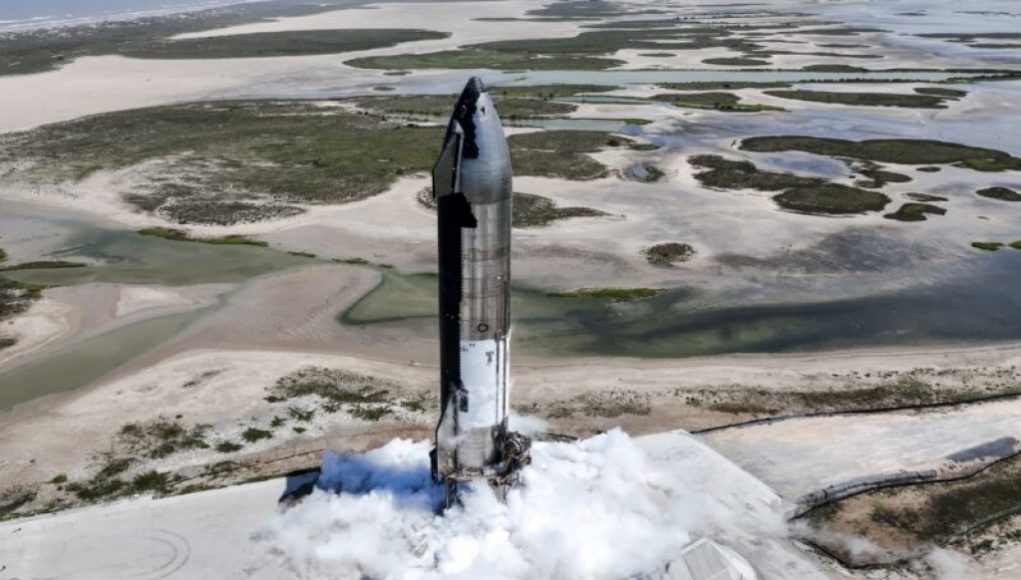Get ready for some major upgrades on SpaceX’s Starship mega-rocket! The second launch will feature changes in how the rocket’s two stages separate, propulsion system improvements, and a stronger launch pad in South Texas. According to Elon Musk, SpaceX’s founder and CEO, there are over a thousand changes between the last Starship flight and this one. He believes that the probability of this next flight working and getting to orbit is much higher than the last one, possibly around 60 percent.
During a Twitter Spaces discussion with journalist Ashlee Vance, Musk outlined some of the modifications to the Starship rocket and the launch pad at the Starbase facility in South Texas. He expects them to be ready for the next test flight in about six weeks. The Starship vehicle is designed to be fully reusable and will be used for various purposes, including hauling satellites into orbit, constructing refueling tankers and propellant depots, and eventually transporting cargo and crew to the Moon and Mars.
One of the most significant changes SpaceX is making to the Starship design is in separating the booster from the upper stage. This event occurs about three minutes after liftoff, and the Starship test flight in April did not reach the stage separation milestone. To increase the Starship’s payload lift capability, SpaceX will use a technique called “hot staging,” where they light the engines of the upper stage while the booster stage engines are still on. This technique is not used on any modern US launch vehicle but has been employed by Russian rockets like the Soyuz for decades.
The change in design means engineers must add shielding to the top of the stainless steel booster, which SpaceX wants to recover and reuse numerous times. Separating the rocket’s stages with the booster engines already shut down causes a loss in thrust, so SpaceX will shut down most of the Super Heavy booster’s engines and then fire the engines on the Starship upper stage simultaneously. This modification will add roughly a 10 percent improvement to the Starship rocket’s payload capacity.
SpaceX officials were pleased with the outcome of the first full-up Starship test flight on April 20, which set the record for the largest and most powerful rocket ever flown. The rocket reached an altitude of about 24 miles before tumbling out of control after multiple engine failures and the loss of the rocket’s steering system. SpaceX’s long-term goal is to replace its workhorse Falcon 9 rocket and Dragon crew capsule with the privately funded Starship vehicle.
The California-based company, SpaceX, has recently announced that they will be implementing over 1,000 modifications to their upcoming Starship rocket. This innovative new launch system is intended to be the most powerful system in operation and will be capable of launching payloads into space up to twice as large as its predecessor, the Falcon 9.
The modifications include improvements to the rocket’s aerodynamics, aerothermal protection, and its ability to better withstand pressure during flight. SpaceX plans to consistently make improvements to the Starship’s ability to maneuver in space, enabling it to take on a wide variety of missions, including Earth-orbiting missions, interplanetary missions, and deep-space exploration.
The company hopes that this robust new system can eventually be used to establish a permanent human presence on Mars as well as facilitate cargo and crew transport. SpaceX has also stated that the Starship rocket will be capable of repeating flights, which will help to reduce costs and launch times significantly.
The rocket boosters for the Starship will be powered by SpaceX’s advanced Raptor engines, which are among some of the most powerful rocket engines ever constructed. While the engines are currently undergoing ground tests, the company is already working on a new version of the engine that will be designed specifically for the Starship.
The Starship is the culmination of years of research and engineering, and SpaceX is confident that it will help humanity achieve new heights in space exploration. Thanks to the modifications, the new launch system will provide the absolute best capabilities when it comes to launching payloads into space.
We can only stand back and marvel at the feats of engineering from the team at SpaceX. With the recent modifications, we may not have to wait very long to witness the Starship rocket begin to explore distant galaxies.




















